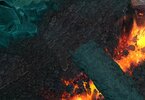I am not aware of an in-game setting that prevents light from reaching the ground in Dungeon tileset.
The game light system chunks terrain into grid squares of 4x4 terrain cells where each cell is size 128x128 (so basically a giant area that is 512x512 units in World Editor -- these are the ones outlined in yellow when grid is on) and then each grid square can have at most 8 lights showing, and beyond that it does not display additional lights.
So, if you have lights that reach a lot of the stuff on the map and use the 8 slots, this can cause the lights to disappear. The way that was calculated has always seemed a bit buggy to me, and I would not be surprised if it might have some bugs where a light uses up a slot on terrain squares nearby or perhaps globally that it did not need to use up, so in a map with a large number of lights you might eventually stop seeing them even when there were not 8 in one place, for some reason -- not sure. I posted a
Hive thread about the problem 16 years ago but nobody seemed to solve it over the last 16 years.
What you probably want to do is to make your Dungeon or Underground map use a different light environment. So, basically, if we assume that your problem isn't a matter of hitting the 8 lights limit, but actually an issue of "fully saturating the ground with light" at all hours of the in-game clock (even at night), then your problem is actually quite simple. You want a different light environment for your Warcraft III map. There are two ways to achieve this:
- Way 1: Import different light environment files in place of the original ones for Dungeon/Underground
- For example, if you look up
Environment\DNC\DNCAshenvale\DNCAshenvaleUnit\DNCAshenvaleUnit.mdx and
Environment\DNC\DNCAshenvale\DNCAshenvaleTerrain\DNCAshenvaleTerrain.mdx and import them back into your map as custom model imports over top of the
Environment\DNC\DNCDungeon\DNCDungeonUnit\DNCDungeonUnit.mdx and
Environment\DNC\DNCDungeon\DNCDungeonTerrain\DNCDungeonTerrain.mdx files, then when you pick Dungeon tileset it will have Ashenvale light environment. You can do the same for Underground
- Way 2: the World Editor will generate your map script to contain the line
call SetDayNightModels("Environment\\DNC\\DNCDungeon\\DNCDungeonTerrain\\DNCDungeonTerrain.mdl","Environment\\DNC\\DNCDungeon\\DNCDungeonUnit\\DNCDungeonUnit.mdl") so if your map script is getting generated or modified by some external program you can change that function call, but if it's not and you're just doing a standard World Editor map then you can literally go into the trigger editor and call the same function with some other inputs. So for example, maybe you could put in some trigger that runs on standard initialization, a simple call to
call SetDayNightModels("war3mapImported\\myTerrainFile.mdl", "war3mapImported\\myUnitFile.mdl") which will load the light environment you want when the map starts.
Note that in either of the above two ways, you're not likely to see the preview in World Editor. If you want to see the preview in World Editor, the easiest way to do this is to mod your game client itself and add the modified file in place of the default one(s).
If you want a custom light environment rather than simply replacing one of the existing ones with a different existing one, the format of these light environment files is to have literally just a standard Warcraft 3 MDX Model that opens in whatever 3D model editor you like, except for the fact that the model contains one single Light Emitter that is the "sun light" with an animation that has a set timeline that needs to stay what it is to match the Day/Night cycle. Notably, if you look at the file for Ashenvale or Lordaeron, this model has a "Light Emitter" that changes color over time and goes to blue at night, but full white color during the day. Hence why you can see your "light emitters" of World Editor during the night only -- during the day, the ground is fully saturated with light and so additional light doesn't change its color.
In a similar way, the Dungeon and Underground tilesets have a light that
does not change to blue at night. So, as a result, they will "fully saturate" most of the ground with light regardless of the time of day.
By understanding this, and customizing the light emitter files, you could have a reversed light environment where the world turns red during the day but shows full color at night, so that light emitters reveal themselves and work only during the day, or all manner of other crazy and custom creations.








